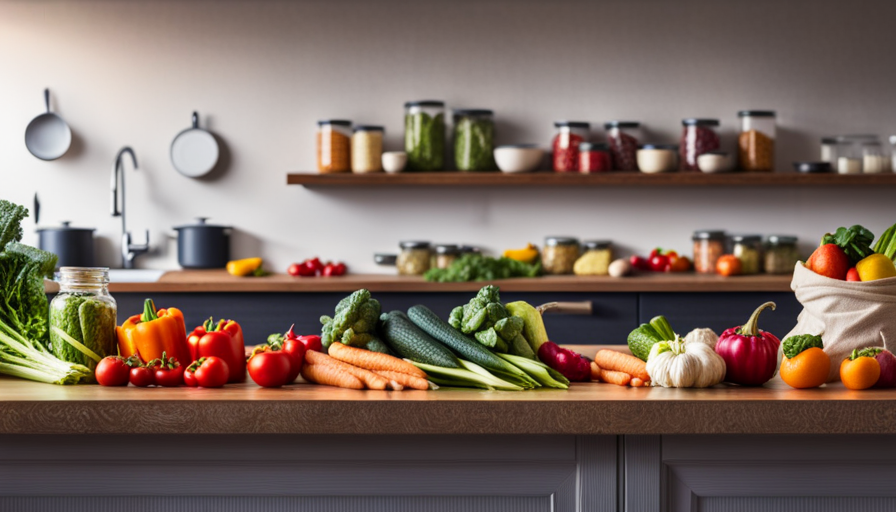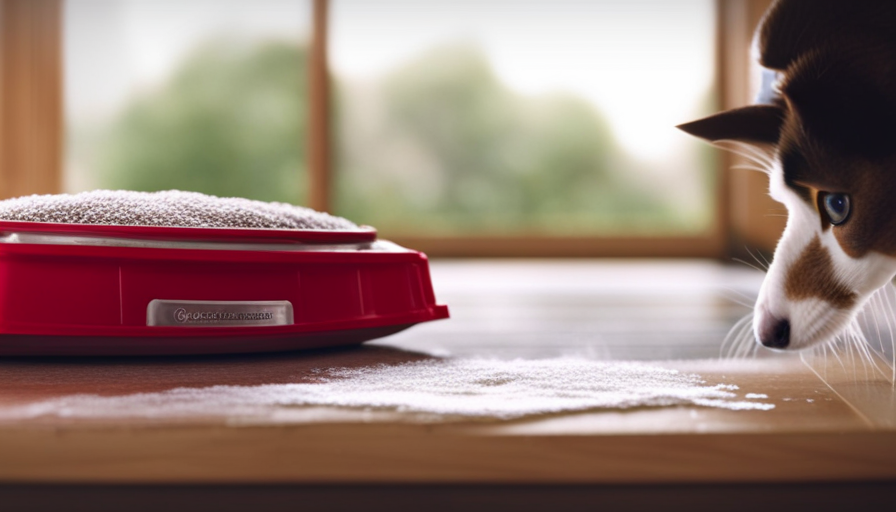‘You are what you eat’ is a well-known phrase that emphasizes the importance of selecting the correct foods for weight loss. This is particularly important for individuals following the Weight Watchers program, as they aim to find healthy, low-calorie options. Chicken is a favored choice due to its versatility and high protein content. The question remains: is it better to consume cooked or raw chicken?
In this article, we will explore the reasons why cooked chicken is preferred over its raw counterpart. Not only does cooked chicken offer more nutritional value, but it also comes with important safety considerations and improved digestibility. We will also discuss the flavor and texture differences between cooked and raw chicken, as well as various cooking methods that can enhance your weight loss journey.
So, let’s dive in and discover why cooked chicken deserves a spot on your Weight Watchers food list.
Key Takeaways
- Cooked chicken provides more nutritional value compared to raw chicken.
- Cooking chicken eliminates harmful bacteria like salmonella.
- Cooking chicken enhances digestibility and nutrient accessibility.
- Thoroughly cooking chicken reduces the risk of foodborne illnesses.
Nutritional Value of Cooked Chicken
Cooked chicken provides a boost in nutritional value that raw chicken simply can’t compete with. When we cook chicken, it undergoes a transformation that enhances its nutritional profile, making it more beneficial for our health.
One of the main reasons cooked chicken is preferred is because it’s easier for our bodies to digest and absorb the nutrients it contains. Cooking breaks down the proteins in chicken, making them more accessible for our digestive system. Additionally, cooking chicken helps to eliminate harmful bacteria, such as salmonella, that may be present in raw chicken. This reduces the risk of foodborne illnesses and ensures our safety.
In terms of specific health benefits, cooked chicken is a great source of high-quality protein, which is essential for building and repairing tissues, producing enzymes and hormones, and supporting a healthy immune system. It also contains important vitamins and minerals like vitamin B12, iron, and zinc. These nutrients play a crucial role in energy production, red blood cell formation, and maintaining a strong immune system.
Now, let’s explore the safety considerations of raw chicken and the potential risks associated with consuming it without proper cooking.
Safety Considerations of Raw Chicken
When handling raw chicken, you need to be cautious of potential safety hazards that can arise. Raw chicken can be contaminated with bacteria such as Salmonella, Campylobacter, and E. coli, which can cause foodborne illnesses. To ensure food safety, it’s important to follow proper handling and cooking practices when dealing with raw chicken. Here are five important safety considerations to keep in mind:
-
Always wash your hands thoroughly with soap and water before and after handling raw chicken.
-
Use separate cutting boards and utensils for raw chicken to avoid cross-contamination with other foods.
-
Store raw chicken in the refrigerator at a temperature below 40°F to prevent bacterial growth.
-
Cook chicken to a minimum internal temperature of 165°F to kill any harmful bacteria.
-
Avoid consuming undercooked chicken or using marinades that have come into contact with raw chicken.
By following these safety precautions, you can reduce the risk of foodborne illnesses associated with raw chicken.
Now, let’s transition into discussing the digestibility of cooked chicken.
Digestibility of Cooked Chicken
When it comes to the digestibility of cooked chicken, two key points to consider are the breakdown of proteins and fats, as well as the ease of digestion.
Cooked chicken is easier for our bodies to break down and absorb the proteins and fats it contains. This is because cooking breaks down the tough connective tissues and denatures the proteins, making them more accessible and easier to digest.
Additionally, cooking helps to render out some of the fat, making it less greasy and more easily digested.
Breakdown of proteins and fats
Did you know that the breakdown of proteins and fats in chicken can vary depending on whether it’s cooked or raw? When chicken is cooked, the proteins denature and the fats melt, resulting in changes to both the flavor and texture of the meat. The breakdown of proteins during cooking can make the chicken more tender and easier to chew. Additionally, cooking can help to break down and render out some of the fat, resulting in a leaner piece of meat.
These changes in the breakdown of proteins and fats can contribute to the overall taste and mouthfeel of cooked chicken. Moving on to the next section about the ease of digestion, it’s important to understand how the cooking process affects the chicken’s digestibility.
Ease of digestion
The breakdown of proteins and fats in chicken can affect how easily it’s digested. When chicken is cooked, the proteins denature and become more accessible for digestion. This means that our bodies can break down the proteins more efficiently, making it easier for us to digest cooked chicken compared to raw chicken.
Additionally, cooking chicken can also render out some of the fat, making it lighter and easier to digest. However, it’s important to note that overcooking chicken can lead to dryness and toughness, which can make it harder to chew and swallow.
As we transition into the subsequent section about flavor and texture differences, it’s worth exploring how different cooking methods can influence the overall eating experience.
Flavor and Texture Differences
When it comes to the flavor and texture of cooked chicken, there are two key points to consider. First, the Maillard reaction that occurs during cooking enhances the taste of the chicken by creating new flavors and aromas. This reaction is responsible for the deliciously browned and crispy skin that many people enjoy.
Second, cooking chicken has a tenderizing effect on the meat. The heat breaks down the connective tissues in the chicken, resulting in a more tender and juicy texture.
Maillard reaction and taste enhancement
Imagine how your taste buds will dance with delight when you savor the succulent flavor of cooked chicken, as the Maillard reaction transforms its proteins and sugars into a delectable symphony of savory notes. And did you know that this reaction can enhance the taste of your dish by up to 200%?
The Maillard reaction and browning: When chicken is cooked, the Maillard reaction occurs, causing the proteins and sugars to react and create new flavor compounds. This reaction is responsible for the delicious aroma and golden-brown color that we associate with cooked chicken.
Impact on nutritional content: While the Maillard reaction enhances the taste of chicken, it may also lead to changes in its nutritional content. Cooking chicken can cause some loss of heat-sensitive vitamins, such as vitamin C and B vitamins. However, it also increases the bioavailability of certain nutrients, making them easier for our bodies to absorb.
Flavor development: Through the Maillard reaction, the flavors of cooked chicken become more complex and intense. The combination of amino acids and reducing sugars produces a range of compounds that contribute to the rich umami taste and desirable aromas.
The Maillard reaction not only adds depth and complexity to the flavor of cooked chicken but also has an impact on its nutritional content. Moving forward, let’s explore the tenderizing effects of cooking.
Tenderizing effects of cooking
Get ready to experience the magical transformation that occurs when you cook chicken, as the tenderizing effects of cooking turn tough meat into melt-in-your-mouth deliciousness.
When chicken is cooked, the heat breaks down the connective tissues and collagen, making the meat more tender. This happens due to the denaturation of proteins, which alters their structure and results in a softer texture.
The longer you cook chicken, the more tender it becomes, but there is a fine balance between tender and overcooked. Taste preferences also play a role, as some people prefer slightly firmer chicken while others enjoy it falling apart.
Cooking times can vary depending on the cut of chicken and the desired texture.
As we delve into the next section about cooking methods for chicken, you’ll discover the best ways to achieve the perfect balance of tenderness and flavor.
Cooking Methods for Chicken
To cook chicken, you’ll want to try different methods such as grilling, baking, or stir-frying, each bringing out unique flavors and textures that’ll leave you craving for more.
Grilling chicken is a popular cooking method that not only adds a smoky flavor but also gives it a nice charred exterior. It’s important to marinate the chicken before grilling to enhance the flavors and keep the meat moist.
Baking is another great option, especially for those who prefer a healthier cooking method. It requires less oil and allows the chicken to cook in its own juices, resulting in tender and juicy meat.
If you’re looking for a quick and easy way to cook chicken, stir-frying is the way to go. It involves cooking the chicken in a hot pan with some oil and tossing it with various vegetables and sauces. This method is perfect for creating flavorful and vibrant dishes in a short amount of time.
Now, let’s explore the benefits of raw chicken for weight loss without taking another step.
Benefits of Raw Chicken for Weight Loss
When it comes to cooking chicken, there are various methods that can be used to prepare a delicious and healthy meal. In the previous section, we discussed different cooking methods for chicken, each with its own unique advantages.
Now, let’s delve into the benefits of consuming raw chicken for weight loss.
Raw chicken is often touted as a healthy option for weight watchers due to its high protein content and low calorie count. Protein is an essential nutrient for weight loss as it helps to increase satiety and boost metabolism. Additionally, raw chicken is rich in vitamins and minerals that are beneficial for overall health.
However, it is important to note that consuming raw chicken carries certain risks. Raw chicken may contain harmful bacteria such as salmonella or campylobacter, which can cause foodborne illnesses. These bacteria are usually killed during the cooking process, making cooked chicken a safer option.
While raw chicken may offer some benefits for weight loss, it is crucial to weigh the potential risks associated with consuming it. Now, let’s move on to the next section where we will explore the risks of raw chicken for weight loss.
Risks of Raw Chicken for Weight Loss
Consuming raw chicken can pose serious health risks due to the potential presence of harmful bacteria, causing illness and jeopardizing overall well-being. It’s important to be aware of these risks, especially when considering weight loss. Here are four key reasons why you should avoid raw chicken when trying to lose weight:
-
Bacterial contamination: Raw chicken can be contaminated with harmful bacteria such as Salmonella and Campylobacter. These bacteria can cause food poisoning, leading to symptoms like vomiting, diarrhea, and abdominal pain. This can hinder your weight loss progress and make you feel unwell.
-
Digestive issues: Raw chicken contains enzymes that can be difficult for the digestive system to break down. This can lead to digestive issues like bloating, gas, and indigestion. Such discomfort can affect your ability to stick to a healthy eating plan and may hinder weight loss efforts.
-
Nutritional deficiencies: Cooking chicken not only kills harmful bacteria but also enhances its nutritional value. Raw chicken may lack essential nutrients like vitamins, minerals, and amino acids. By consuming cooked chicken, you ensure that you’re getting the necessary nutrients to support your weight loss goals.
-
Food safety regulations: Health authorities advise against consuming raw chicken due to the risk of bacterial contamination. It’s important to follow recommended cooking temperatures and guidelines to ensure food safety and minimize the risk of illness.
Transitioning into the subsequent section about recommended cooking temperatures for chicken, it’s crucial to know the ideal cooking temperatures to eliminate any potential risks while enjoying a delicious and safe meal.
Recommended Cooking Temperatures for Chicken
In the previous section, we discussed the risks of consuming raw chicken for weight loss. Now, let’s talk about the recommended cooking temperatures for chicken. Properly cooking chicken is essential to ensure its safety and maintain its nutritional value. Cooking techniques such as baking, grilling, or sautéing can help you achieve the desired results.
To ensure that chicken is cooked thoroughly, it is recommended to use a food thermometer. The internal temperature of cooked chicken should reach at least 165°F (74°C) to kill any harmful bacteria. This temperature ensures that the chicken is safe to eat and reduces the risk of foodborne illnesses.
Cooking chicken also offers numerous health benefits. It helps destroy harmful bacteria, prevents food poisoning, and improves digestibility. Additionally, cooking chicken helps break down proteins, making them easier for our bodies to absorb and utilize.
To summarize, cooking chicken to the recommended temperatures is crucial for both safety and health benefits. By following proper cooking techniques and using a food thermometer, you can enjoy the deliciousness of cooked chicken while ensuring its safety. The next section will delve into personal preference and individual needs when it comes to choosing the right chicken preparation.
Personal Preference and Individual Needs
Everyone has their own unique tastes and dietary requirements, so it’s important to consider personal preferences and individual needs when it comes to choosing how to prepare chicken.
Some people may prefer to eat their chicken cooked because they enjoy the flavors and textures that result from the cooking process. Others may have dietary restrictions that require them to eat cooked chicken to ensure food safety.
On the other hand, some individuals may prefer to eat raw chicken due to its nutritional value and potential health benefits. However, it’s important to note that consuming raw chicken comes with risks, such as salmonella contamination. Therefore, it’s crucial to handle and prepare raw chicken properly to minimize these risks.
Additionally, some individuals with specific dietary restrictions, such as those following a paleo or raw food diet, may choose to eat raw chicken to align with their eating principles.
Ultimately, the decision to eat cooked or raw chicken depends on personal preferences and individual needs, but it’s essential to prioritize food safety and follow recommended cooking guidelines.
Considering these factors, let’s now move on to the conclusion and considerations section.
Conclusion and Considerations
Ultimately, it’s crucial to consider individual preferences and dietary needs when deciding how to prepare this versatile poultry staple. Personal preference plays a significant role in determining whether one chooses to consume cooked or raw chicken. Some individuals may prefer the taste and texture of cooked chicken, finding it more flavorful and easier to digest. On the other hand, others may have a preference for raw chicken, citing its natural and unaltered state as the reason for their choice.
However, health considerations should also be taken into account. Cooking chicken thoroughly helps eliminate harmful bacteria, such as salmonella, that can cause foodborne illnesses. Raw chicken, on the other hand, poses a higher risk of bacterial contamination if not handled and prepared properly. Therefore, it’s important to ensure that chicken is cooked to a safe internal temperature of 165°F (74°C) to reduce the risk of foodborne illnesses.
Additionally, cooking chicken can also enhance its nutritional value. While raw chicken contains essential nutrients, cooking can make these nutrients more bioavailable, allowing our bodies to absorb them more efficiently. For example, cooking chicken increases the availability of protein, making it easier for our bodies to digest and utilize.
When deciding between cooked or raw chicken, personal preference and health considerations should be taken into account. While personal taste and texture preferences may vary, it’s important to prioritize food safety by thoroughly cooking chicken to reduce the risk of foodborne illnesses. Furthermore, cooking chicken can enhance its nutritional value, making it a healthier choice overall.
Frequently Asked Questions
Can I use raw chicken instead of cooked chicken in my Weight Watchers meal plan?
Yes, it’s generally recommended to use cooked chicken instead of raw chicken in your weight watchers meal plan. Raw chicken carries potential health risks, such as salmonella and other bacterial infections. Cooking chicken thoroughly helps eliminate these risks. Additionally, cooking methods like grilling, baking, or boiling can help reduce the amount of fat and calories in the chicken, making it a healthier choice for your weight loss journey.
What are the potential health risks of eating raw chicken on a weight loss journey?
There are potential health risks associated with eating raw chicken on a weight loss journey. Raw chicken can contain harmful bacteria like Salmonella and Campylobacter, which can cause food poisoning. These bacteria can lead to symptoms like diarrhea, vomiting, and abdominal pain, which can disrupt your weight loss progress.
Cooking chicken thoroughly kills these bacteria, making it safer to consume. It’s important to prioritize food safety and cook chicken properly to minimize the potential risks on your weight loss journey.
Are there any specific cooking methods for chicken that are more beneficial for weight loss?
There are several cooking methods for chicken that can be beneficial for weight loss. Grilling or baking chicken without added fats or oils can help reduce the calorie content.
Poaching chicken in water or broth is another healthy option. These methods retain the natural flavors of chicken without adding extra calories.
Additionally, avoiding deep-frying or breading chicken can further support weight loss goals. Choosing the right cooking methods can help you enjoy chicken while staying on track with your weight loss journey.
How does the flavor and texture of cooked chicken differ from raw chicken?
When it comes to the flavor and texture of cooked chicken, there are noticeable differences compared to raw chicken. Cooking techniques, such as grilling, baking, or frying, can enhance the flavor by adding a delicious smoky or crispy taste.
The texture of cooked chicken becomes tender and juicy, making it easier to chew and enjoy. These flavor differences and cooking techniques make cooked chicken a more appetizing and satisfying choice for many people.
Is the nutritional value of cooked chicken significantly different from raw chicken?
The nutritional benefits of cooking chicken are significant compared to eating it raw. Cooking chicken kills harmful bacteria, such as salmonella, reducing the risk of foodborne illnesses. Additionally, cooking increases the bioavailability of nutrients like protein, making it easier for our bodies to absorb.
However, it’s important to follow safety precautions when handling raw chicken, such as washing hands and utensils thoroughly to prevent cross-contamination. Cooking chicken thoroughly ensures both its safety and nutritional value.
What Are the Food Safety Guidelines for Cooking Chicken on the Weight Watchers Food List?
When following the Weight Watchers Food List, it’s important to adhere to the food safety rules when cooking chicken. Ensure that the chicken is cooked to the recommended internal temperature of 165°F to kill any harmful bacteria. Avoid cross-contamination by using separate cutting boards for raw chicken and other ingredients.
Conclusion
In conclusion, when it comes to weight loss and overall health, choosing cooked chicken over raw chicken is a wise decision. Cooked chicken not only offers a higher nutritional value, but it also eliminates safety concerns and enhances digestibility.
The flavor and texture differences between cooked and raw chicken are like night and day, making the cooking process truly transformative. By following recommended cooking temperatures, we can ensure that our chicken is safe to consume.
Ultimately, the choice between cooked and raw chicken comes down to personal preference and individual needs. So, let’s savor the symbolism of cooking our chicken and enjoy the delicious journey to a healthier lifestyle.










